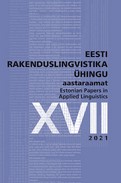KUIDAS ANALÜÜSIDA EESTI LASTE HÄÄLDUSPUUDEID?
HOW TO ANALYSE SPEECH SOUND DISORDERS IN ESTONIAN CHILDREN?
Author(s): Marju Lahtein, Marja-Liisa Mailend, Marika PadrikSubject(s): Phonetics / Phonology, Comparative Linguistics, Psycholinguistics, Finno-Ugrian studies
Published by: Eesti Rakenduslingvistika Ühing (ERÜ)
Keywords: speech sound disorders; assessment; psycholinguistics; speech development; Estonian;
Summary/Abstract: The article discusses speech sound disorders in Estonian children from a psycholinguistic perspective. The focus is on the phonological and phonetic aspects of the Estonian language that are substantially different in comparison to well-studied Germanic languages. The topic is relevant to everyone with an interest in speech development but especially for speech-language pathologists, who are tasked with the diagnosis and remediation of this prevalent class of communication disorders. The gold standard for differentiating speech sound disorders from typical development relies on developmental norms of speech production, which are currently lacking for Estonian-speaking children. Thus, speech-language pathologists have to rely on investigations conducted in languages other than Estonian and their own experience in diagnosing speech sound disorders. Identifying the disorder is only the first step. For effective treatment planning it is also important to understand the underlying processes that manifest in a speech sound disorder. In this article we argue that a process-oriented approach based on psycholinguistic theory is best suited for this goal. The discussion focuses primarily on speech sound disorders arising from the phonological and phonetic planning levels of speech production, because similarities in the behavioral presentations of these disorders make differential diagnosis difficult. Considering speech sound disorders in the context of findings from other languages and in the context of features that are specific to Estonian leads to several conclusions and suggestions for future investigations. The article identifies a number of aspects of the Estonian language (e.g., segmental quantity and rich vowel inventory) that may prove particularly fruitful for studying the manifestation and differential diagnosis of speech sound disorders in Estonian children.
Journal: Eesti Rakenduslingvistika Ühingu aastaraamat
- Issue Year: 2021
- Issue No: 17
- Page Range: 177-192
- Page Count: 16
- Language: Estonian

